Appalachian Engine: The Virginia Creeper Trail Keeps Bringing Visitors Back
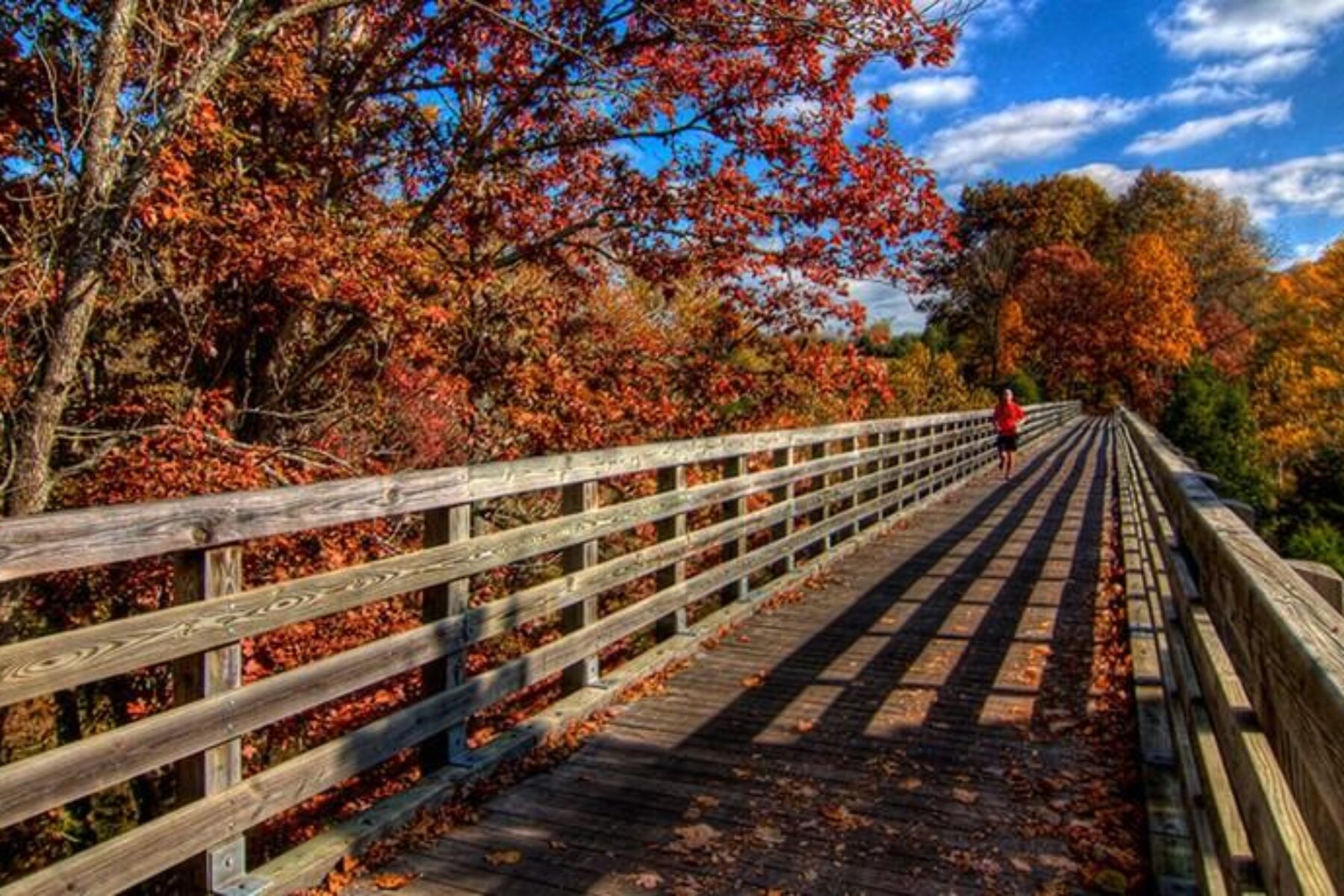
It’s a bright August morning, and every seat on the Virginia Creeper Trail shuttle is filled. The van wends its way up Whitetop Mountain, slowing to hug each curve on the old logging road that winds to the summit. We pass weathered log cabins, fields of perfect, cone-shaped Christmas trees and miles of tall oaks. Three teenage girls—maybe 16 or 17—sit in the front seat, chatting like old friends with the driver and swapping memories with each other. They recall the first ride down the mountain. The plunge into a trailside creek after biking right through a hornet’s nest. The double-dip ice cream cones enjoyed at the base of the mountain.
Seated behind them, the girls’ fathers and uncles laugh and tease about the hornet misadventure. And one passenger— a little older than the girls—sits quietly, taking it all in. It’s his last trip as “one of the kids,” I learn. He will enter the military at the end of the summer.
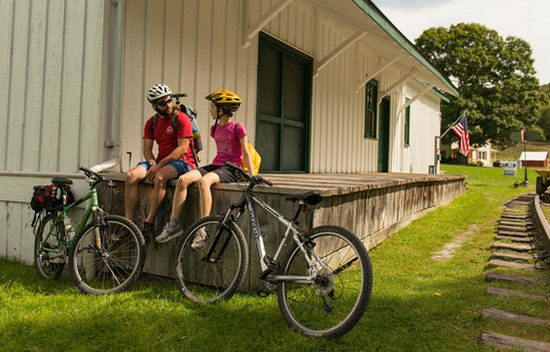
For these young adults who come annually for family reunions, Southwest Virginia’s 34-mile Virginia Creeper Trail (VCT) is timeless. It’s a place, they’ve discovered, where cell phones serve no purpose and where horses share the path. A place where the loudest sound you’ll hear for miles is the thud-thud of your bike tires across the planks of towering wooden trestles.
Though it may feel antique to the families who return year after year, the VCT is a fairly recent development—and one that almost didn’t happen. The trail is a beloved regional asset and economic boon that once ignited fierce opposition from neighboring landowners. A relic of the railroad age, it came within a pen stroke of simply vanishing into the forest. The story of the Virginia Creeper Trail is the tale of an idea that gripped two small-town doctors and a local lawmaker—and then simply wouldn’t let go.
Trail Info
States: Virginia
Counties: Grayson, Washington
Length: 33.7 miles
Trail end points: 300 Green Spring Rd. (Abingdon) and 2053 Dolinger Rd. (Whitetop)
Trail surfaces: Gravel
Trail category: Rail-Trail
Campaign for the Creeper
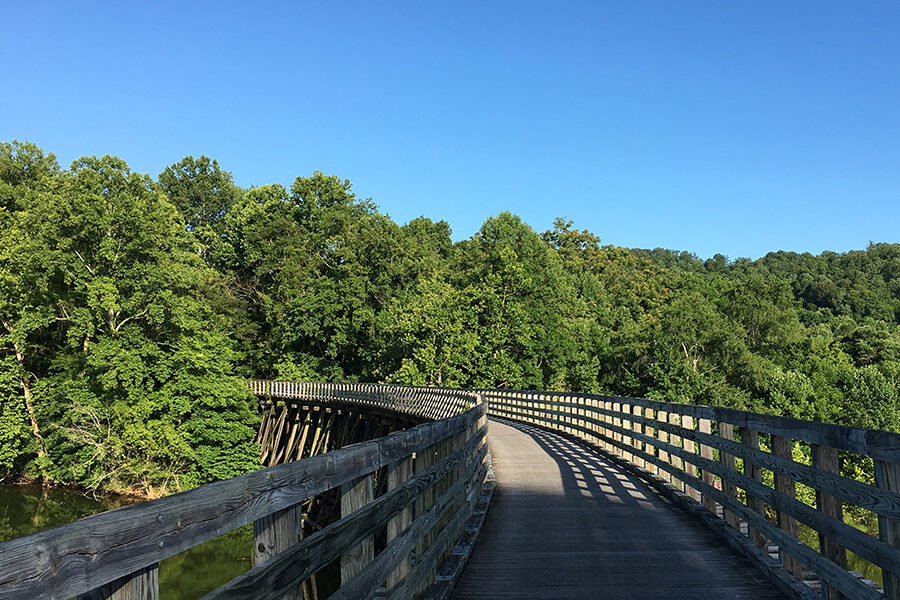
The rail line that was once the highest elevation passenger service train east of the Rockies made its last run in 1977. The Norfolk & Western Railway’s Abingdon line, dating back to the late 1800s, transported timber from the old-growth forest on Whitetop Mountain to a Damascus, Va., lumber mill. The line became known as “The Virginia Creeper” because of the train’s creeping pace up and down steep mountain grades. In the late 1920s, the local lumber industry shut down. Yet the Creeper chugged along another 50 years, transporting passengers and assorted dry goods—and serving as a vital line of connection in the region.
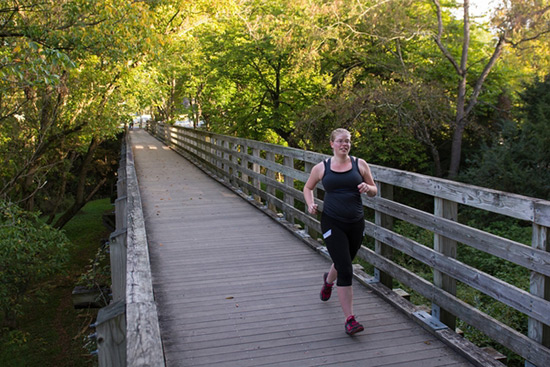
Dr. French Moore Jr., an Abingdon, Va., dentist who chaired Washington County’s planning commission in the late 1970s, remembers the first time he heard the idea of converting the old rail line to a trail. A Washington Post story of a defunct Wisconsin rail line turned into a hiking trail had sparked the imagination of Moore’s planning commission colleague, Dr. Dave Brillhart, an Abingdon physician who shared the story with Moore. The idea took root. “I just couldn’t let it go,” Moore recalls. “I knew we’d only have the opportunity…for a moment in time.”
The U.S. Forest Service (USFS) jumped on the chance to purchase the right-of-way for the 19-mile stretch of rail line running through the Mount Rogers National Recreation Area, from Damascus to the North Carolina state line. Meanwhile, in a separate, local effort, Moore and Brillhart began a tireless campaign to develop the full 34-mile trail that would last most of the next decade. The task was daunting: Trail advocates would have to purchase the remaining 15 miles of right-of-way between Damascus and Abingdon, acquire and save 47 trestles that had already been sold to a salvage company, build and make the trail safe for visitors, and figure out matters of local oversight and upkeep.
Allies and Adversaries in Abingdon
The two activists knew they’d need a public advocate for their cause. They found that in their state senator, Rick Boucher, whom they approached early in the campaign for help in negotiating with the railroad. Boucher, who practiced law in Abingdon, donated legal assistance while championing the trail initiative at the state level. Moreover, after being elected to the U.S. Congress in 1982, Boucher proposed a bill, which was enacted, to upgrade the trail right-of-way and secured more than $2 million in federal funds to preserve the Virginia Creeper Trail as a National Recreation Trail.
“I just kept going … I always believed the trail would be a success—something no one can ever take away from us.”
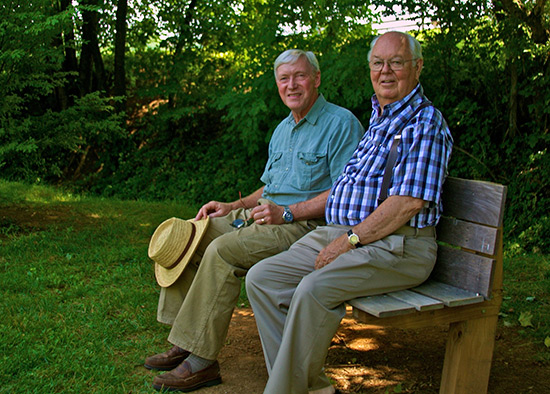
Despite Boucher’s advocacy and the tenacity of Moore and Brillhart, efforts to create the trail were met with formidable obstacles. The ribbon of land connecting mountain to towns was quickly becoming what Moore describes as an “underground railroad”—a place that attracted vandals and illegal hunters. Despite concerns about such uses, many landowners worried that a trail on the old rail corridor would bring trespassers to their farms. These farmers (some of whom also happened to be Moore’s patients) protested the trail effort, made their own attempts to purchase the land and even filed a lawsuit.
“I just kept going,” Moore says. “I always believed the trail would be a success—something no one can ever take away from us.”
And in 1981, the dream of local ownership of the line became a reality. Armed with $28,000 in grants, Brillhart and Boucher arranged for the towns of Damascus and Abingdon jointly to buy the right-of-way that would become the first 15 miles of the VCT. It took another six years to restore the wooden trestles, an effort that was interrupted in 1985 when one of the 450-foot bridges burned down in a mysterious fire.
Finally, in 1987, the long-awaited 34 miles of converted rail line opened to the public as a shared-use hiking, biking and equine recreational trail.
Managing the trail is a joint effort of the USFS and the municipalities of Abingdon and Damascus. While the USFS trail section is run separately from the section owned by the two towns, the three entities cooperate on trail upkeep—with the Virginia Creeper Trail Club providing plenty of volunteer labor to aid in that job.
Economic Engine, Priceless Asset
Today the sleepy towns of Abingdon and Damascus welcome about 250,000 trail riders a year, more than 25 times their combined populations. The trail is an economic engine for the communities, generating business for bike shuttle services, rental cottages, restaurants and shops. Jerry Camper, co-owner of the Virginia Creeper Trail Bike Shop, has been onboard from the start. In 2002, he and his brother risked their savings to open up their shop with just a handful of rental bikes. Today, with 200 bikes out at a time, they can barely keep up with demand. On a summer day at 9 a.m. opening time, the place is buzzing. When Camper is not loading bikes onto the shuttle for hourly runs up to the mountain, he’s grabbing the phone to take reservations. Word has gotten out about the beautiful, easy coast down the mountain on the Creeper.
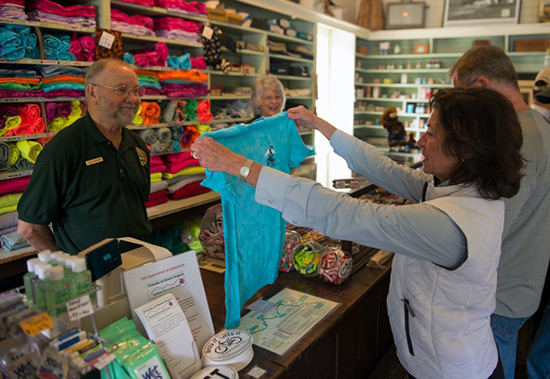
“The trail has proven to be a tremendous asset,” Boucher says. The Town of Abingdon couldn’t agree more. According to Tenille Montgomery, former marketing coordinator for the town, studies show that each overnight trail visitor spends more than $700 while staying in the area. And according to the town’s best estimates, trail-related tourism revenues stand at about $25 million a year.
Merchants aren’t the only beneficiaries. Wayne Miller, president of the Virginia Creeper Trail Club, says homeowners have seen jumps in property value, the artisans and musicians of an Abingdon-based folk culture collective are finding new outlets, and farmers enjoy growing demand for their produce. In fact, some of the farmers who once vocally opposed the trail—Moore’s old patients—now leave baskets of free vegetables and flowers for trail users.
And trespassing on private land hasn’t been a problem: The trail’s woods, rolling hills and meadows—and 47 trestles over gorges and rivers—keep riders focused on the adventure in front of them.
Trailpreneur Spotlight:
Virginia Creeper Trail Bike Shop
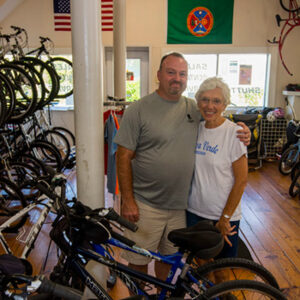
When Jerry and Gary Camper started the Virginia Creeper Trail Bike Shop 12 years ago just yards from the Abingdon trailhead, their goal was to sell bikes and shuttle riders up Whitetop Mountain. While they were at it, they figured they’d keep a small fleet of rentals on hand. The business was one of the first to target the VCT bike tourism market. The trail was seeing roughly 20,000 out-of-town visitors a year (about one-fifth the current estimate). The brothers knew their best strategy was to start small, learn what their customers wanted and build from there.
They quickly found that what their customers most wanted was a package deal—a sturdy mountain bike to rent for the day and a ride up to Whitetop Station. The fleet of 10 rental bikes quickly grew to 30, and by 2010, the bike business had become 70 percent rental.
The Camper brothers now have a rental inventory of about 200 bikes and offer that rental/shuttle package. Jerry says he often has to turn away customers who don’t make advance reservations for the summer and fall trail seasons. In 2011, the Campers opened up a second location in Damascus so they could shuttle customers easily from both towns that serve as bookend hubs for the VCT.
After 12 years of serving VCT riders (many of whom come in big family groups), Jerry says it’s the return customers and the widening radius of new business that excite him the most. “I’ve seen kids grow up. I’m seeing my clients age…and I’ve met folks from as far away as South Africa.”
“Creepers Barter”—and Stop for Cake
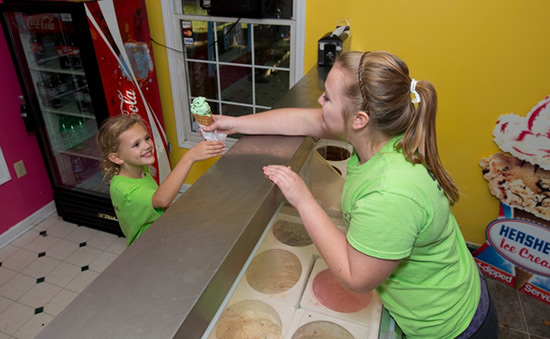
To serve the needs and interests of the growing number of out-of-town visitors, trail stakeholders studied where VCT visitors go and what they do during their stay. A few findings were obvious: People coming to ride the trail stay at trail-accessible inns and cottages. They patronize the bike rental/shuttle shops and stop at trailside eateries.
But some less obvious findings also emerged, with implications for future outreach efforts. Miller points to the Barter Theatre, Abingdon’s biggest cultural draw. A large percentage of overnight trail visitors buy tickets for the Barter; yet, those who come mainly for the performances rarely visit the trail—demonstrating the way in which the trail serves as a conduit by which people are drawn to, and reach, local civic attractions. “Creepers Barter, but Barters don’t Creep,” Miller chuckles.
Of course, Creepers do a lot more than “Barter.” They get off the trail to enjoy whatever local color (and food and drink) they can spot from their bike seats. They buy souvenirs at the hundred-year-old Green Cove train station, sample local craft brews at the two trailside microbreweries and taste the wines at Abingdon Vineyard & Winery. The Creeper Trail Café, a packed trailside lunch stop near the base of the mountain, embodies the leisurely spirit of the VCT. Customers chat and greet one another while waiting in line to order a burger and a slice of the owner’s famous chocolate cake. A large world map behind the register, swathed in a rainbow of pushpins, reminds guests that the trail has become a destination for trail enthusiasts from the world over.
Fred Leonard owns the Damascus Old Mill Inn, a 12-room bed and breakfast with a full-service restaurant located just a block from the Damascus trailhead. His hotel guests are a mix of VCT riders and theatergoers, “folks who want a little more upscale experience.” The restaurant guests who come off the trail, he says, want to have a nice dinner or just sit outside with a cold drink. “Here in Damascus,” Leonard explains, “since we’re the gateway to the most popular recreational part of the trail, business is always good. And in September and October, it just explodes.”
It’s All About the Bikes
For Abingdon Economic Development Director Kevin Costello, the biggest challenge in increasing tourism is gathering concrete visitor data, beginning with numbers of trail users. A lot of guesswork is required when counting visitors on a public-access trail. But one critical fact Costello knows for sure is that each year, nearly 100,000 visits begin with a stop at one of the local bike rental shops.
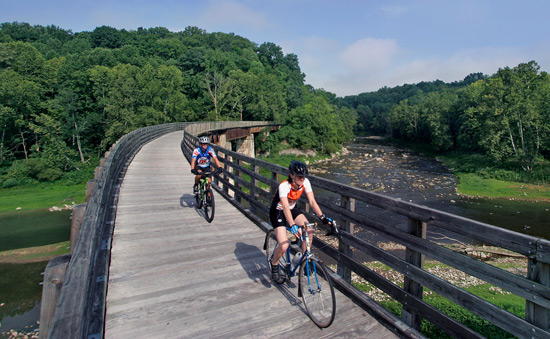
Abingdon’s first priority, according to Costello, is to welcome those out-of-town riders before they hit the trail. A new trailhead visitor’s center, which opened in October, showcases the area’s growing array of businesses. The town is also tackling an ambitious project to make all of Abingdon—from the Barter Theatre to the many specialty shops—bike accessible. The project, called Urban Pathways, will unfold incrementally, developing “bits and pieces” of right-of-way to connect riders to restaurants, shops and inns.
“I’m also trying to reach out to craft bicycle manufacturers about creating a Virginia Creeper Trail bike designed just for our trail,” says Costello. “Why not bring the bike manufacturer here? As much as possible, we want to see the tourism dollars stay local.”
Whether you talk with shop owners, town officials, trail volunteers or innkeepers, you’ll hear a single refrain: “People always come back.” Like the family on the shuttle up to Whitetop, they come back for the breezy, shady ride down the mountain. They come back for the wild beauty of the trail and the antique luster of the towns, just as Moore predicted nearly 40 years ago. The pathways to capturing the full economic potential of the Virginia Creeper Trail are still emerging, but one thing is clear: Each visitor on a bike brings the promise of new vitality to this corner of Appalachia.
And each return visit gives the locals a new reason to treasure the remarkable trail that spans mountain, forest, field, river and lake. The trail that draws entire families back year after year. The trail that very nearly disappeared.
This excellent feature originally appeared as the cover story in the Winter 2015 edition of Rails to Trails magazine. One of many perks provided when you become an RTC member, our quarterly magazine includes lots of great stories like this.

Donate
Everyone deserves access to safe ways to walk, bike, and be active outdoors.
